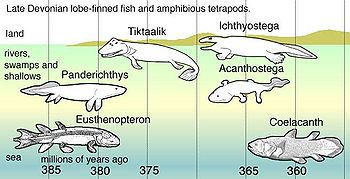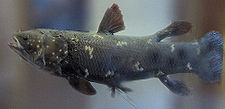- Sarcopterygii
-
Sarcopterygii
Temporal range: Late Silurian–Recent, 418–0 Ma
Modern coelacanth, Latimeria chalumnae Scientific classification Kingdom: Animalia Phylum: Chordata Subphylum: Vertebrata Class: Sarcopterygii
Romer, 1955Subclasses - Coelacanthimorpha — Coelacanths
- Dipnoi — Lungfish
- Tetrapodomorpha — Tetrapods and their extinct relatives.
The Sarcopterygii /ˌsɑrkɒptəˈrɪdʒi.aɪ/ or lobe-finned fishes (from Greek σαρξ sarx, flesh, and πτερυξ pteryx, fin) – sometimes considered synonymous with Crossopterygii ("fringe-finned fish", from Greek κροσσός krossos, fringe) constitute a clade (traditionally a class or subclass) of the bony fishes, though a strict classification would include the terrestrial vertebrates. The living sarcopterygians are the coelacanths, lungfishes, and the tetrapods.
Contents
Characteristics
Early sarcopterygians - crossopterygians are bony fish with fleshy, lobed, paired fins, which are joined to the body by a single bone.[1] The fins of crossopterygians differ from those of all other fish in that each is borne on a fleshy, lobelike, scaly stalk extending from the body. Pectoral and pelvic fins have articulations resembling those of tetrapod limbs. These fins evolved into legs of the first tetrapod land vertebrates, amphibians. They also possess two dorsal fins with separate bases, as opposed to the single dorsal fin of actinopterygians (ray-finned fish). The braincase of sarcoptergygians primitively has a hinge line, but this is lost in tetrapods and lungfish. Many early sarcopterygians have a symmetrical tail. All sarcopterygians possess teeth covered with true enamel.
Taxonomists who subscribe to the cladistic approach include the grouping Tetrapoda within this group, which in turn consists of all species of four-limbed vertebrates.[2] The fin-limbs of sarcopterygians such as the coelacanths show a strong similarity to the expected ancestral form of tetrapod limbs. The crossopterygians apparently followed two different lines of development and are accordingly separated into two subclasses, the Rhipidistia (including the Dipnoi or lungfish, and the Tetrapodomorpha which include the Tetrapoda) and the Actinistia (coelacanths).
Evolution
 In Late Devonian vertebrate speciation, descendants of pelagic lobe-finned fish — like Eusthenopteron — exhibited a sequence of adaptations: * Panderichthys, suited to muddy shallows; * Tiktaalik with limb-like fins that could take it onto land; * Early tetrapods in weed-filled swamps, such as: ** Acanthostega, which had feet with eight digits, ** Ichthyostega with limbs. Descendants also included pelagic lobe-finned fish such as coelacanth species.
In Late Devonian vertebrate speciation, descendants of pelagic lobe-finned fish — like Eusthenopteron — exhibited a sequence of adaptations: * Panderichthys, suited to muddy shallows; * Tiktaalik with limb-like fins that could take it onto land; * Early tetrapods in weed-filled swamps, such as: ** Acanthostega, which had feet with eight digits, ** Ichthyostega with limbs. Descendants also included pelagic lobe-finned fish such as coelacanth species.
Sarcopterygians and their relatives the actinopterygians ("ray-finned fish") comprise the superclass Osteichthyes, the "bony fish", characterized by their bony skeleton rather than cartilage. There are otherwise vast differences in fin, respiratory, and circulatory structures between the Sarcopterygii and the Actinopterygii. The first sarcopterygians, found in the uppermost Silurian (ca 418 Ma), closely resembled the Acanthodians (the "spiny fish", a taxon that went extinct at the end of the Paleozoic). In the early–middle Devonian (416 - 385 Ma), while the predatory placoderms dominated the seas, some sarcopterygians came into freshwater habitats.
In the Early Devonian (416 - 397 Ma), the sarcopterygians split into two main lineages — the coelacanths and the rhipidistians. The former never left the oceans and their heyday was the late Devonian and Carboniferous, from 385 to 299 Ma, as they were more common during those periods than in any other period in the Phanerozoic; coelacanths still live today in the oceans (genus Latimeria).
The Rhipidistians, whose ancestors probably lived in the oceans near the river mouths (estuaries), left the ocean world and migrated into freshwater habitats. They in turn split into two major groups : the lungfish and the tetrapodomorphs. The lungfish evolved the first proto-lungs and proto-limbs; they learned in the middle Devonian (397 - 385 Ma) how to live outside a water environment, using their stubby fins (proto-limbs) to walk on land and find new water if their waterhole was depleted, and their lungs to breathe air and get sufficient oxygen. The lungfish's greatest diversity was in the Triassic period; today there are fewer than a dozen genera left.
The first tetrapodomorphs, which included the gigantic rhizodonts, had the same general anatomy as the lungfish, who were their closest kin, but they appear not to have left their water habitat until the late Devonian epoch (385 - 359 Ma), with the appearance of tetrapods (four-legged vertebrates). Tetrapods are the only tetrapodomorphs which survived after the Devonian.
Non-tetrapod sarcopterygians continued until towards the end of Paleozoic era, suffering heavy losses during the Permian-Triassic extinction event (251 Ma).
Classification
Taxonomy
The classification below follows Benton 2004, and uses a synthesis of rank-based Linnaean taxonomy and also reflects evolutionary relationships. Benton included the Superclass Tetrapoda in the Subclass Sarcopterygii in order to reflect the direct descent of tetrapods from lobe-finned fish, despite the former being assigned a higher taxonomic rank.[3]
- Subclass Sarcopterygii
-
-
- Order Dipnoi
-
- Infraclass Crossopterygii
-
- †Order Porolepiformes
- †Order Onychodontida
- Order Actinistia
-
- Infraclass Tetrapodomorpha
- †Order Rhizodontida
- Superorder Osteolepidida
- †Order Osteolepiformes
- †Family Tristichopteridae
- †Order Panderichthyida
- Superclass Tetrapoda
- †Order Osteolepiformes
-
Phylogeny
The cladogram presented below is based on studies compiled by Philippe Janvier and others for the Tree of Life Web Project.[4]
Sarcopterygii ?†Onychodontiformes
Coelacanthimorpha (coelacanths)
unnamed Dipnoi (lungfish)
unnamed unnamed Terrestrial vertebrates
See also
- List of Sarcopterygii
- Actinopterygii — ray-finned fish
References
- ^ Clack, J. A. (2002) Gaining Ground. Indiana University
- ^ Nelson, Joseph S. (2006). Fishes of the World. John Wiley & Sons, Inc. ISBN 0-471-25031-7.
- ^ Benton, M.J. (2004). Vertebrate Paleontology. 3rd ed. Blackwell Science Ltd
- ^ Janvier, Philippe. 1997. Vertebrata. Animals with backbones. Version 01 January 1997 (under construction). http://tolweb.org/Vertebrata/14829/1997.01.01 in The Tree of Life Web Project, http://tolweb.org/
Extant Chordata classes by subphylum Urochordata (Tunicates) Cephalochordata (Lancelets) Craniata Myxini (Hagfish) · Hyperoartia (Lampreys) · Chondrichthyes (Cartilaginous fish) · Actinopterygii (Ray-finned fish) · Sarcopterygii (Lobe-finned fish) · Amphibia (Amphibians) · Sauropsida (Reptiles) · Aves (Birds) · Mammalia (Mammals)Coelacanthimorpha Dipnoi Categories:- Lobe-finned fish
- Bony fish
Wikimedia Foundation. 2010.

